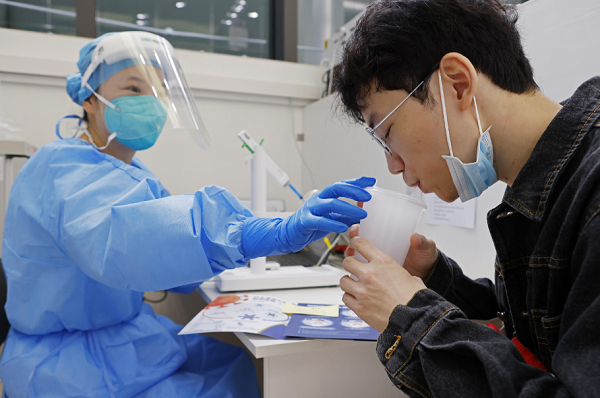
Inhaled COVID-19 vaccination is launched in Shanghai last month. [Photo/CHINA NEWS SERVICE]
Concrete changes
The notice issued on Friday is set to trigger more concrete changes beyond virus control for the manufacturing sector and cross-border visits.
Wang Hao, governor of the major manufacturing province of Zhejiang, said during a news conference on Friday that when an outbreak occurs, at least 80 percent of factories in areas at risk should try to maintain operations, and that at least 80 percent of production capacity should be sustained.
In the United States, Liu Xinyi, a Chinese citizen living in Texas, was relieved to hear that the circuit breaker system — a mechanism that halts international air routes if positive cases are found onboard flights — had been abolished.
"This means that more flights to China will be resumed and that airfares will drop. An economy ticket from Texas to China used to cost as much as $6,000, but now I reckon the price is around $2,000," Liu said.
On Friday, the Civil Aviation Administration of China said it would advance the recovery of air passenger travel in line with the policy modification.
Liu said that reducing the centralized quarantine period for international passengers is also a boon for the elderly and children, who often find it harder to adjust to unfamiliar isolation facilities.
Continuing battle
Wang Liping, a researcher at the Chinese Center for Disease Control and Prevention, said regular monitoring and taking early precautions against the epidemic should be stepped up. Sufficient testing, epidemiological investigation, quarantine and community management resources should be prepared, Wang added.
In Guangzhou, some quarantined groups released from centralized facilities over the weekend will need to undergo home-based isolation for three more days, as required.
"The new rule poses different requirements for the community management of such groups, and our community managers are making adaptations," Zhang, from the local center for disease control and prevention, said.
Zhang said it will be challenging to implement the new risk categorization in certain areas of the densely populated city, where some buildings are extremely close together.
"It is a test of our epidemiological survey capacity, and we should be even more meticulous," he said.
Du Juan in Beijing, Tan Yingzi in Chongqing, Yuan Hui in Hohhot and Cang Wei in Nanjing contributed to this story.